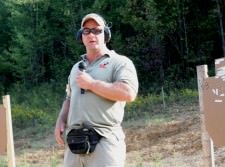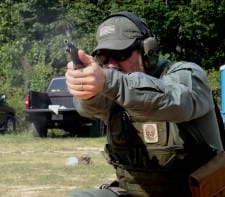

Biloxi, Mississippi — (Ammoland.com) – I begin this piece not with malice or antagonism in my heart, but with genuine concern. For nearly thirty years I’ve carried a firearm professionally and for better than two decades I’ve been involved in teaching others to do the same. I’ve written innumerable articles, papers, and even a couple of books that centered on the use of arms. More importantly, I’ve had the privilege to attend myriad professional schools and training academies to include those run by the U.S. military and state law enforcement as well as those operated privately. The great fortune to train with some of the leading firearms instructors in the world has befallen me.
The previous information was offered as an attempt to assuage the knee-jerk reactions of some who may feel that what follows is a deliberate attempt to insult their religion. Yes, the term ‘religion’ is used quite deliberately, as many gun owners and toters defend their choice of hardware and employment of said hardware with the zeal of one who is protecting the honor of their chosen faith. Insult is not my intent though I do fear it is inevitable.
To Make the Fluid Rigid
While the use of paraphrase is never as valid as a direct quote, I believe I can be forgiven in this instance as I cannot seem to put my hands on my copy of The Tao of Jeet Kune Do by Bruce Lee. As I recall, Lee expressed frustration with the way the martial arts were being delivered and taught to Westerners in the United States. Lee expressed that the, then contemporary, instructors had taken that which was once fluid and forced it into a strict mold, they’d made it rigid.
That was not to say that the modern instructors of his day did not possess skill, they indeed did. But, these men had become masters of repetitive movement and had turned what was once a dynamic form of physical combat into a regimented game. If your aim is be the very best at a game or a sport, there is certainly no shame in that endeavor. The folly comes when skill at sport is confused with skill in mortal combat.
In his Book of Five Rings, Miyamoto Musashi offers a warning that, “The ‘Way’ cannot be learned through frivolous contests in which the outcome is for the name of a school or a large trophy. It can only be realized where physical death is a reality.” What does all this martial arts, Eastern mumbo-jumbo have to do with good ole fashion American gunfighting? I’m glad you asked.
Motion for Motion’s Sake
There has been an ongoing trend in the firearm training community to add or insert heretofore unheard of or unforeseen techniques in order make the shooting stance or method “look better”. It’s a bit of the “New and Improved Tide” syndrome. That is, if it’s new it’s got to be better. Motions that were once simple and uncomplicated now become complex and multifaceted.
In order to dazzle the audience, extra movements, gyrations and theatrics are added. That which was once a lackluster shooting demonstration now becomes a super-cool, totally ninja exhibition. My good friend Jay Gibson put it to me this way. “That movement isn’t for the shooter’s benefit. It’s for the benefit of those watching the shooter.”
It’s tough to fault these schools and instructors for adding ninja moves to their shooting techniques. After all, the consumer craves ‘new and improved’, they want to be dazzled. If you don’t dazzle them, they won’t buy the product. Again referring back to games versus combat, if playing a shooting sport is your goal, mastery of extraneous and complex moves is really not that big of a deal. Drive on brother and have fun.

The Deadly Conundrum
When faced with the harsh reality of mortal combat and the potential of losing one’s life, playing games and engaging in some kind of tactical kabuki dance can be quite perilous. Here’s an example; while instructing at the Expeditionary Combat Skills School for the U.S. Military I encountered a student who, when his pistol ran dry, would eject the empty magazine into his support hand and then deliberately throw it behind him, sometimes several yards, before reaching for a loaded magazine to refill his gun. We did not teach that in our school.
After watching the young trooper do this a few times I walked up behind him and in the most consoling voice I could muster whispered in his ear; “Are those magazines evil?” He turned and looked at me with astonishment and said “No.” “Then why are you trying so hard to cast them behind you?” I queried.
“I don’t want to risk stepping on them and lose my balance.” He replied. It seemed that at a previous school throwing empty magazines was a technique they’d be taught. Big deal you say. Let the kid throw his magazines, what’s it hurting? Answer: On the square range it doesn’t hurt a thing and gives you extra PT time as you search for your gear after the drill is complete.
However, the purpose of our training was preparation for mortal combat. In a gunfight if your blaster stops making noise and the bad guys are still standing you have a problem. Priority Number 1 is to get something in your hands that will continue to make noise and inflict harm upon the bad men. The general solution is to retrieve more ammo, stick it in your gun and drive on in the most expeditious manner possible. Wasting precious moments to cast your magazine far from your body would seem a superfluous act, especially considering the fact that unless you are behind solid cover you will likely be moving your feet, not standing still on the square range.
Another thorn under my saddle is the schools that teach: Tactical, Combat, Emergency, and Administrative loading of self-loading firearms. The student is taught three or four different methods for charging their blaster. During the high anxiety of a lethal force encounter, or even a stress filled training exercise, when said student’s firearm stops making noise they go through an exercise in mental jumping jacks to determine which of the multiple ways of putting ammunition back in the gun is appropriate according to the previously received instruction. Invariably, when this was the programming a student had undergone I would witness a brief but discernible ‘vapor lock’ while the student made a self-correction so as not to feel like they were “doing it wrong”.
This is not Paul Markel’s snarky opinion. If you teach someone three methods for accomplishing the same task, under stress they will have to make some kind of decision as to which method is correct. Instead of continuing to fight, they are second guessing or pausing to consider their options. Again, on the one-way shooting range it’s no biggie, on the two-way shooting range not so much.
Another concern is the “tactical walking” concept. Again, in the Book of 5 Rings, Musashi states that, “There is no difference in walking and running in battle and walking and running everyday life except for speed.” You spend your entire life walking one way and then only a miniscule amount walking in combat. To attempt to alter the way your body moves during the stress of a fight is a recipe for disaster.
To offer an additional real life example, I was coaching a student during a shoot and move exercise against steel silhouettes. The student would shoot two silhouettes a minimum of two times each and then quickly move to the next set of targets. My pupil was moving along briskly, striking each target, clang, clang…clang, clang. Suddenly, a range officer came running up and yelled “Cease fire!” My kid froze in place. “What’s up?” I asked. “His feet are wrong.” The man stated. I was speechless.
My student was hitting each target without a problem but this guy wanted him to stop and ‘fix’ his feet. What was the point of the exercise; to hit the target or to walk and stand in a certain way? Are we teaching close order drill or fighting?

Fighting or Ball Room Dancing
Going back to our martial arts example, Bruce Lee was frustrated at what he saw as an over-exaggeration of form versus function. What was more important, how the person looked when he threw the punch or how effective the punch was? In the Western martial art of Gunfighting, what is more important, how you look on the square range or how effectively you strike the target with your rounds? Do we get extra style points in combat? Will the enemy be so impressed by your Tactical Kabuki Dance that they wilt and surrender?
Rather than add extraneous movements and flashy ninja techniques to our shooting method, I would suggest that we instead remove any and all movement that does not add to the overall effectiveness of the mission; delivering rounds on target efficiently.
Max Michel, the National and World Speed Shooting champion can deliver rounds on target faster than most human beings on the planet. To the tactical ninja crowd, Mr. Michel’s form would seem a bit benign. Max’ movements are direct and deliberate. There is not one single extra, flashy or extraneous action in his form. Max built his shooting method on the foundation of balance, economy of motion, and working with the natural tendencies of the human body, not against them, and with great success I might add.
Sports, games, and ball room dancing can all be enjoyable activities and I fully endorse them. Nonetheless, do not confuse success in sport or even on the static, square range with success in the most dynamic, fluid and potentially deadly activity you may be forced to undertake. Thus ends the reading.
*Credit to my good friend, Jay Gibson, for teaching me how to put the thing in the thing and pull on the thing.
Paul Markel © 2013
Student of the Gun is the #1 source for education, enjoyment and enlightenment of real-world firearms: training, videos, radio, books and articles. A beginner once, a student for life. www.studentofthegun.com
Student of the Gun: “A beginner once, a student for Life.”
